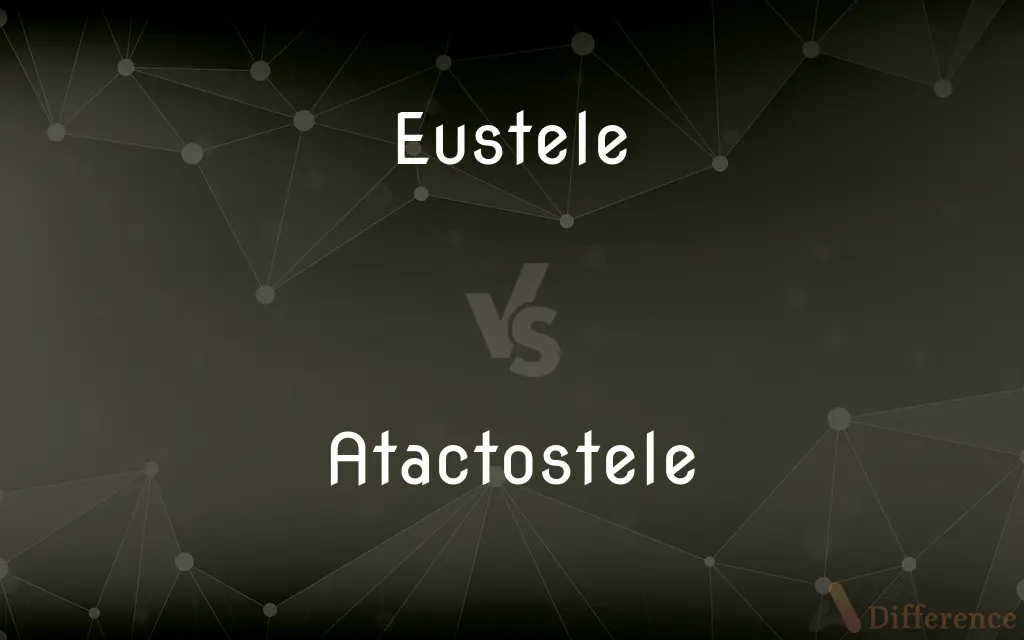Eustele vs. Atactostele — What's the Difference?
By Fiza Rafique & Urooj Arif — Updated on April 28, 2024
Eustele is a type of stele found in most dicot plants characterized by a ring of vascular bundles, while atactostele is a scattered vascular arrangement typical in monocots.

Difference Between Eustele and Atactostele
Table of Contents
ADVERTISEMENT
Key Differences
Eustele, observed in most dicots, features a distinct ring of vascular bundles surrounding the pith and phloem outside the xylem. On the other hand, atactostele, characteristic of monocots, displays vascular bundles distributed irregularly throughout the stem without a defined arrangement.
In the eustele configuration, the vascular bundles are usually arranged in a circle, allowing for the potential growth of secondary tissues via cambium. Whereas in atactostele, the bundles are scattered and usually lack cambium, preventing typical secondary growth.
The vascular bundles in eustele are also typically collateral, with xylem on the inside and phloem on the outside. Conversely, atactostele may feature vascular bundles that are also collateral but are interspersed across the stem's ground tissue.
This arrangement in eustele facilitates the division of the stem into distinct cortical and pith regions, enhancing structural stability. In contrast, atactostele results in a more homogeneous stem structure, which can affect the plant's mechanical support.
Eustele is adaptive for growth in environments where structural support and resource transport efficiency are crucial, supporting taller growth. Meanwhile, atactostele is suited to environments where flexibility and rapid growth are more advantageous, as seen in many grasses.
ADVERTISEMENT
Comparison Chart
Arrangement
Ring-shaped
Scattered
Cambium Presence
Present
Absent
Vascular Bundle Type
Collateral
Collateral
Secondary Growth
Possible
Not typical
Typical Occurrence
Dicots
Monocots
Compare with Definitions
Eustele
A type of stele characterized by a ring of vascular bundles.
The eustele is commonly seen in dicotyledonous plants.
Atactostele
Suits rapid and flexible growth requirements.
The bamboo’s atactostele facilitates its quick growth.
Eustele
Supports the plant's ability to grow taller and thicker.
The oak tree’s eustele contributes to its large, sturdy trunk.
Atactostele
A scattered arrangement of vascular bundles typical in monocots.
Palm trees feature the atactostele for vascular tissue.
Eustele
Features vascular cambium between xylem and phloem.
Eustele's presence of cambium allows for increased diameter growth.
Atactostele
Lacks a concentric arrangement, with bundles spread throughout the stem.
In atactostele, vascular bundles are embedded in ground tissue.
Eustele
Stele with discrete vascular bundles primarily in dicots.
Eustele arrangement supports secondary growth.
Atactostele
Generally does not support secondary growth due to absence of cambium.
Grasses with atactostele do not thicken over time.
Eustele
Organizes vascular tissue into a ring around the central pith.
In eustele, the ring formation aids in structural support.
Atactostele
Helps in adapting to environments where quick recovery from damage is beneficial.
Atactostele in grass allows it to recover quickly from grazing.
Eustele
A stele in which the primary vascular tissue is arranged in bundles around a pith, as in most seed plants.
Atactostele
(botany) A type of eustele, found in monocots, in which the vascular tissue in the stem exists as scattered bundles.
Eustele
(botany) A type of siphonostele, in which the vascular tissue in the stem forms a central ring of bundles around a pith.
Common Curiosities
What is the main structural difference between eustele and atactostele?
Eustele has a ring-shaped arrangement of vascular bundles, whereas atactostele has a scattered distribution.
How does atactostele contribute to a plant's flexibility?
The scattered arrangement of atactostele allows for greater flexibility and rapid growth.
Why might atactostele be advantageous in certain environments?
Its scattered vascular bundles help plants like grasses quickly recover from damage and adapt to varying conditions.
Are vascular bundles in both eustele and atactostele collateral?
Yes, both have collateral vascular bundles, but their arrangement differs.
Which type of stele is more common in trees?
Eustele is more common in trees, particularly in dicots.
Which type of stele allows for secondary growth?
Eustele allows for secondary growth due to the presence of cambium.
In which types of plants is eustele primarily found?
Eustele is primarily found in dicots.
Can atactostele support secondary growth?
Typically, atactostele does not support secondary growth because it lacks cambium.
How does the presence of cambium in eustele affect plant growth?
Cambium allows for the growth in diameter, supporting secondary growth and increasing structural stability.
Do all monocots have atactostele?
While most monocots have atactostele, not all strictly adhere to this pattern.
What are some common examples of plants with atactostele?
Grasses, palms, and other monocots typically exhibit atactostele.
How does atactostele affect the mechanical support of a plant?
The homogeneous structure might reduce specific structural support but increases flexibility.
What advantage does the eustele arrangement provide to dicots?
It provides structural support and facilitates efficient transport of resources, supporting taller growth.
How do the vascular arrangements of eustele and atactostele impact their ecological adaptations?
Eustele supports environments requiring durability and height, whereas atactostele is suited for environments prioritizing rapid growth and recovery.
What are some common examples of plants with eustele?
Many dicotyledonous trees and shrubs, like oaks and roses, have eustele.
Share Your Discovery

Previous Comparison
Micro vs. Mini
Next Comparison
Corporation vs. CooperationAuthor Spotlight
Written by
Fiza RafiqueFiza Rafique is a skilled content writer at AskDifference.com, where she meticulously refines and enhances written pieces. Drawing from her vast editorial expertise, Fiza ensures clarity, accuracy, and precision in every article. Passionate about language, she continually seeks to elevate the quality of content for readers worldwide.
Co-written by
Urooj ArifUrooj is a skilled content writer at Ask Difference, known for her exceptional ability to simplify complex topics into engaging and informative content. With a passion for research and a flair for clear, concise writing, she consistently delivers articles that resonate with our diverse audience.













































